Research on Ground Directional Grouting Reinforcement Technology and Coupling Control of Fault Fracture Zone Through Rock Roadway
Abstract
1. Introduction
2. Project Profile
2.1. General Geology
2.2. Technical Difficulties in Engineering
- (1)
- High difficulty of roadway formation: In the proposed control area, due to the influence of the fault fracture zone, the rock mass is broken, and it is difficult to form a roadway via direct excavation, and the subsequent maintenance is difficult.
- (2)
- Complex geological structure: Lianxiang needs to pass through the F2 fault and the Wugou fault, which have a large fault drop and a wide distribution of the fracture zone.
- (3)
- Difficulty of slurry diffusion: due to the influence of the fault fracture zone, the grouting slurry may run out of slurry, resulting in low grouting pressure that is unable to effectively reinforce the treatment area.
- (4)
- The excavated roadway is susceptible to grouting. Due to the close distance between the control area and the three uphill areas, it may cause adverse effects such as roof subsidence and floor heave.
3. Evolution Law of Surrounding Rock of Rock Roadway Crossing Fault Fracture Zone
3.1. Three-Dimensional Model Construction of Rock Roadway Crossing Fault Fracture Zone
3.2. Gradient Evolution Law of Stress Partition of Surrounding Rock in Fault-Crossing Rock Roadway
4. Ground Directional Pre-Grouting Reinforcement Technology
4.1. Advantages of Ground Directional Pre-Grouting Technology
4.2. Study on Similar Simulation Test of Pre-Grouting Reinforcement
4.3. Key Technical Processes
4.3.1. Directional Drilling
4.3.2. Grouting Hole Layout
4.3.3. Key Technology of Grouting
- (1)
- Slurry density selection: first, the slurry is used for trial injection to understand the size of the hole section grouting volume and the change in orifice pressure; then, the slurry concentration is adjusted.
- (2)
- Grouting pressure: Grouting pressure is the power source of grout diffusion in cracks, which should be adapted to the formation conditions, grout performance, and the required diffusion distance. When the grouting pressure is too small, the designed grouting diffusion distance cannot be achieved, and the grouting effect is poor. When the grouting pressure is too large, the diffusion distance is too large, resulting in unnecessary waste. Grouting adopts the grouting method of a ‘constant pressure variable’; that is, the fixed grouting pump volume is selected, and the slurry density is adjusted to make the actual grouting pressure ≥ the design grouting pressure, and the grouting pump volume is adjusted from large to small.
- (3)
- The criterion for the end of grouting: when the grouting pressure reaches 1.5 to 2.5 times the hydrostatic pressure, the pump volume is less than 60 L/min, and the stabilization time reaches 30 min, so the grouting process is completed.
- (4)
- Hole sealing: after the grouting of all branch holes, a single liquid cement slurry is used for grouting and sealing.
5. Control Technology of Surrounding Rock
6. Engineering Applications
6.1. Grouting Scheme
6.2. On-Site Implementation and Monitoring
7. Conclusions
- (1)
- Through the FLAC3D numerical simulation software, the model of a roadway crossing the fault fracture zone is constructed, and the stress evolution law of the surrounding rock of the roadway crossing the fault is explored. The three areas of the penetrating fault, which are located in the fault and penetrating fault zones, are analyzed emphatically, which provides a basis for roadway excavation and support.
- (2)
- The diffusion characteristics of the slurry under various grouting hole arrangements were explored using the COMSOL software, which provided a reference for the arrangement of grouting holes.
- (3)
- The ground directional pre-grouting reinforcement technology is proposed to effectively reinforce the fault fracture zone so that the roadway can be driven through the fault fracture zone quickly and safely. It enriches the technical means of roadway crossing faults and has important application value.
Author Contributions
Funding
Institutional Review Board Statement
Informed Consent Statement
Data Availability Statement
Acknowledgments
Conflicts of Interest
References
- Cao, D.; Zhan, W.F.; Li, H.; Li, X.; Liu, D.; Wei, Y. Tectonic setting and risk zoning of dynamic geological disasters in coal mines in China. J. China Coal Soc. 2020, 45, 2376–2388. [Google Scholar]
- Chen, D.D.; Wu, Y.Y.; Xie, S.; Guo, F.; He, F.; Liu, R. Reasonable location of stopping line in close-distance underlying coal seam and partition support of large cross-section roadway. Int. J. Coal Sci. Technol. 2020, 9, 55. [Google Scholar] [CrossRef]
- Wang, Q.Q.; Li, W.P. Application of directional borehole grouting technology to structural complex floor reinforcement in deep underground coal mine. Fresenius Environ. Bull. 2020, 29, 7208–7218. [Google Scholar]
- Zhao, Z.H.; Gao, X.J.; Ma, Q. Impact Hazard Assessment of Mine Roadway Excavation in Fault and Karst Erosion Area. In Proceedings of the 9th China-Russia Symposium “Coal in the 21st Century: Mining, Intelligent Equipment and Environment Protection”, Qingdao, China, 18–21 October 2018; Volume 176, pp. 54–62. [Google Scholar]
- Yang, Y.S.; Fang, Z.M.; Ji, G.; Zhao, B.; Wei, S. Study on Mechanical Properties and Control Technology of Surrounding Rock in the Fracture Zone of a Roadway. Shock Vib. 2021, 2021, 6628593. [Google Scholar] [CrossRef]
- Wang, S.G.; Ding, Z.D.; Shi, C.; Cai, H.; Chen, Y.; Ding, W.; Huang, J. Dislocation response of ECC-RC composite supporting structures of tunnels passing through active fault. Sci. Rep. 2024, 14, 15199. [Google Scholar] [CrossRef]
- Xie, S.R.; Li, H.; Chen, D.D.; Feng, S.; Yang, J.; Ma, X.; Jiang, Z.; Xing, S. Research on the Control Technology and Key Parameters of External Anchor-Internal Unloading of Surrounding Rock During Gob-Side Entry Driving Under Severe Mining of 1000-m-Deep Mine. Rock Mech. Rock Eng. 2024, 57, 2913–2932. [Google Scholar] [CrossRef]
- Wang, L.; Lu, W. A New Approach to Studying the Mechanical Characteristics of the Anchoring–Grouting System in Broken Surrounding Rock. Sensors 2023, 23, 8931. [Google Scholar] [CrossRef]
- Zu, Z.H.; Wang, W.J.; Zhao, F.J.; Wang, D.K.; Ye, Z.Y. Study on Combination Support for High Stressed Soft Rock Roadway. Prog. Min. Sci. Saf. Technol. Pts A B 2008, 7, 1642–1645. [Google Scholar]
- Kong, P.; Jiang, L.S.; Shu, J.; Wang, L. Mining Stress Distribution and Fault-Slip Behavior: A Case Study of Fault-Influenced Longwall Coal Mining. Energies 2019, 12, 2494. [Google Scholar] [CrossRef]
- Li, T.; Li, Z.; Liu, F. Study on Mechanical Characteristics of Rock Surrounding the Roadway under Different Section Shapes. Minerals 2022, 12, 1504. [Google Scholar] [CrossRef]
- Rong, H.; Guo, K.P.; Sun, D.; Luo, M.; Dong, W.; Huo, B. Research on main influencing factors and complete support technology for dynamic pressure and large deformation roadway. Sci. Rep. 2023, 13, 4136. [Google Scholar] [CrossRef] [PubMed]
- Zhang, B.; Zhou, H.Q.; Chang, Q.; Zhao, X.; Sun, Y. The Stability Analysis of Roadway near Faults under Complex High Stress. Sci. Adv. Civ. Eng. 2020, 2020, 8893842. [Google Scholar] [CrossRef]
- Pan, W.; Li, H.; Hua, X.; Liu, B.; Li, C. Research on grouting reinforcement technology of fault crossing roadway in fully mechanized mining face with large dip angle. Bull. Eng. Geol. Environ. 2024, 83, 216. [Google Scholar] [CrossRef]
- Wang, E.; Chen, G.B.; Yang, X.; Zhang, G.; Guo, W. Study on the Failure Mechanism for Coal Roadway Stability in Jointed Rock Mass Due to the Excavation Unloading Effect. Energies 2020, 13, 2515. [Google Scholar] [CrossRef]
- Shan, R.L.; Li, Z.L.; Wang, C.; Wei, Y.; Bai, Y.; Zhao, Y.; Tong, X. Research on the mechanism of asymmetric deformation and stability control of near-fault roadway under the influence of mining. Eng. Fail. Anal. 2021, 127, 105492. [Google Scholar] [CrossRef]
- Lan, T.W.; Liu, Y.H.; Yuan, Y.; Fang, P.; Ling, X.; Zhang, C.; Li, Y.; Li, Y.; Feng, W. Determination of mine fault activation degree and the division of tectonic stress hazard zones. Sci. Rep. 2024, 14, 12419. [Google Scholar] [CrossRef]
- Guo, W.H.; Cao, A.Y.; Hu, Y.; Xue, C.; Liu, Y.; Lv, D. Stress distribution and rockburst characteristics of roadway group under the influence of fault and fold structures: A case study. Geomat. Nat. Hazards Risk 2022, 13, 736–761. [Google Scholar] [CrossRef]
- Zhao, C.X.; Li, Y.; Liu, G.; Meng, X. Mechanism analysis and control technology of surrounding rock failure in deep soft rock roadway. Eng. Fail. Anal. 2020, 115, 104611. [Google Scholar] [CrossRef]
- Wang, E.; Yin, S.F.; Cheng, Z.; Xie, S.; Chen, L.; Kang, Q.; Duan, Y. Failure mechanism analysis of ultra-large-section soft-rock roadway in kilometer deep coal mine and its collaborative control of “grouting-anchoring-pouring”. Eng. Fail. Anal. 2025, 170, 109338. [Google Scholar] [CrossRef]
- Zhu, D.; Zhu, Z.D.; Zhang, C.; Dai, L.; Wang, B. Numerical Simulation of Surrounding Rock Deformation and Grouting Reinforcement of Cross-Fault Tunnel under Different Excavation Methods. Comput. Model. Eng. Sci. 2024, 138, 2445–2470. [Google Scholar] [CrossRef]
- Kang, Y.S.; Liu, Q.S.; Xi, H.; Gong, G. Improved compound support system for coal mine tunnels in densely faulted zones: A case study of China’s Huainan coal field. Eng. Geol. 2018, 240, 10–20. [Google Scholar] [CrossRef]
- Wang, K.; Wang, L.G.; Ren, B. Failure Mechanism Analysis and Support Technology for Roadway Tunnel in Fault Fracture Zone: A Case Study. Energies 2021, 14, 3767. [Google Scholar] [CrossRef]
- Wu, J.X.; Jiao, J.K.; Zhou, S.S. Controlling large deformations in soft rock roadways with integrated anchor shotcrete and grouting techniques. Sci. Rep. 2024, 14, 28339. [Google Scholar] [CrossRef]
- Wang, K.; Wang, L.G.; Ren, B.; Fan, H. Study on Seepage Simulation of High Pressure Grouting in Microfractured Rock Mass. Geofluids 2021, 2021, 6696882. [Google Scholar] [CrossRef]
- Qian, D.Y.; Zhang, N.; Zhang, M.; Shimada, H.; Cao, P.; Chen, Y.; Wen, K.; Yang, S.; Zhang, N. Application and evaluation of ground surface pre-grouting reinforcement for 800-m-deep underground opening through large fault zones. Arab. J. Geosci. 2017, 10, 285. [Google Scholar] [CrossRef]
- Ju, J.F.; Xu, J.L.; Yang, J. Experimental Study on the Flow Behavior of Grout Used in Horizontal Directional Drilling Borehole Grouting to Seal Mining-Induced Overburden Fractures. Geofluids 2021, 2021, 8823902. [Google Scholar] [CrossRef]
- Li, M.J.; Zhang, D.X.; Li, W.F.; Li, S. Research on Pre-Grouting Technology of upper Weathering and Oxidation plane of coal bed drilling by L-shaped Feather Branch Hole. Coal Eng. 2019, 51, 38–41. [Google Scholar]
- Meng, Q.B.; Han, L.J.; Qi, B.; Wen, S.; Chen, K.; Huang, X.; Sun, M. Study and application of key technology for roadway crossing faults under complex geological conditions. J. Min. Saf. Eng. 2017, 34, 199–207. [Google Scholar]
- Zhang, Y. Study on Bearing Characteristic of Composite Bolt-Rock Bearing Structure and Its Application in Roadway Bolting Design. Ph.D. Thesis, China University of Mining and Technology, Beijing, China, 2013. [Google Scholar]

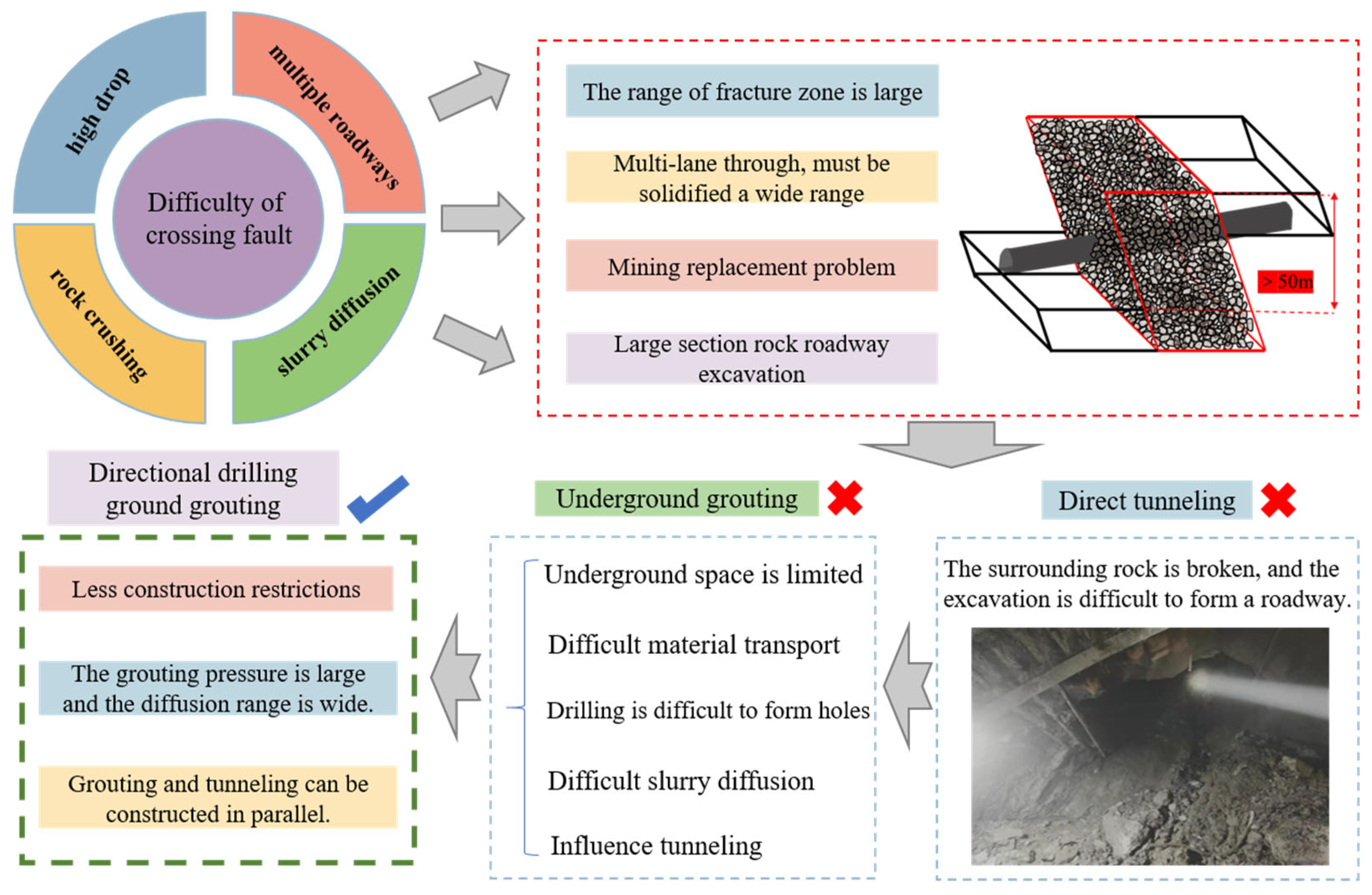
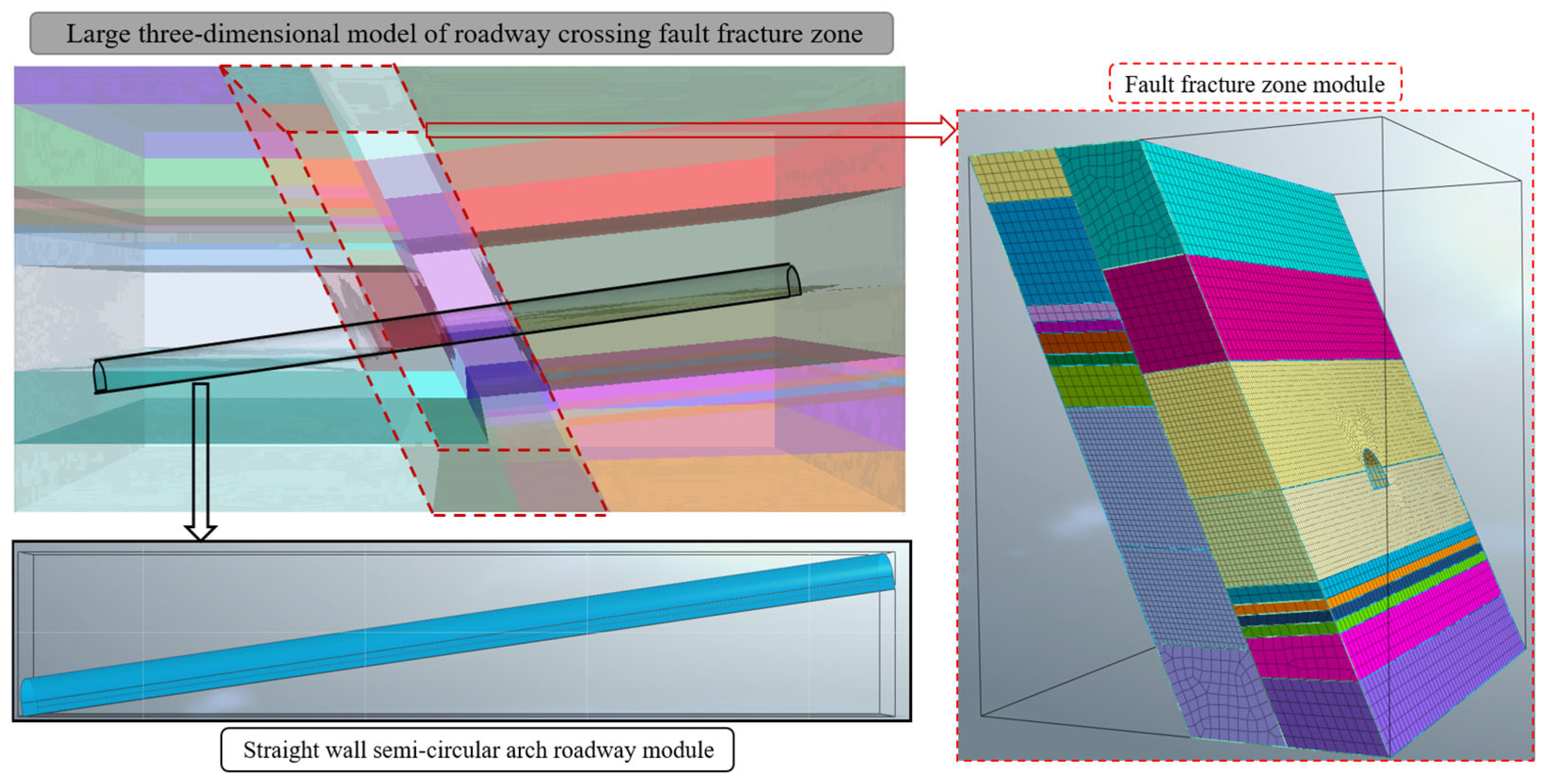
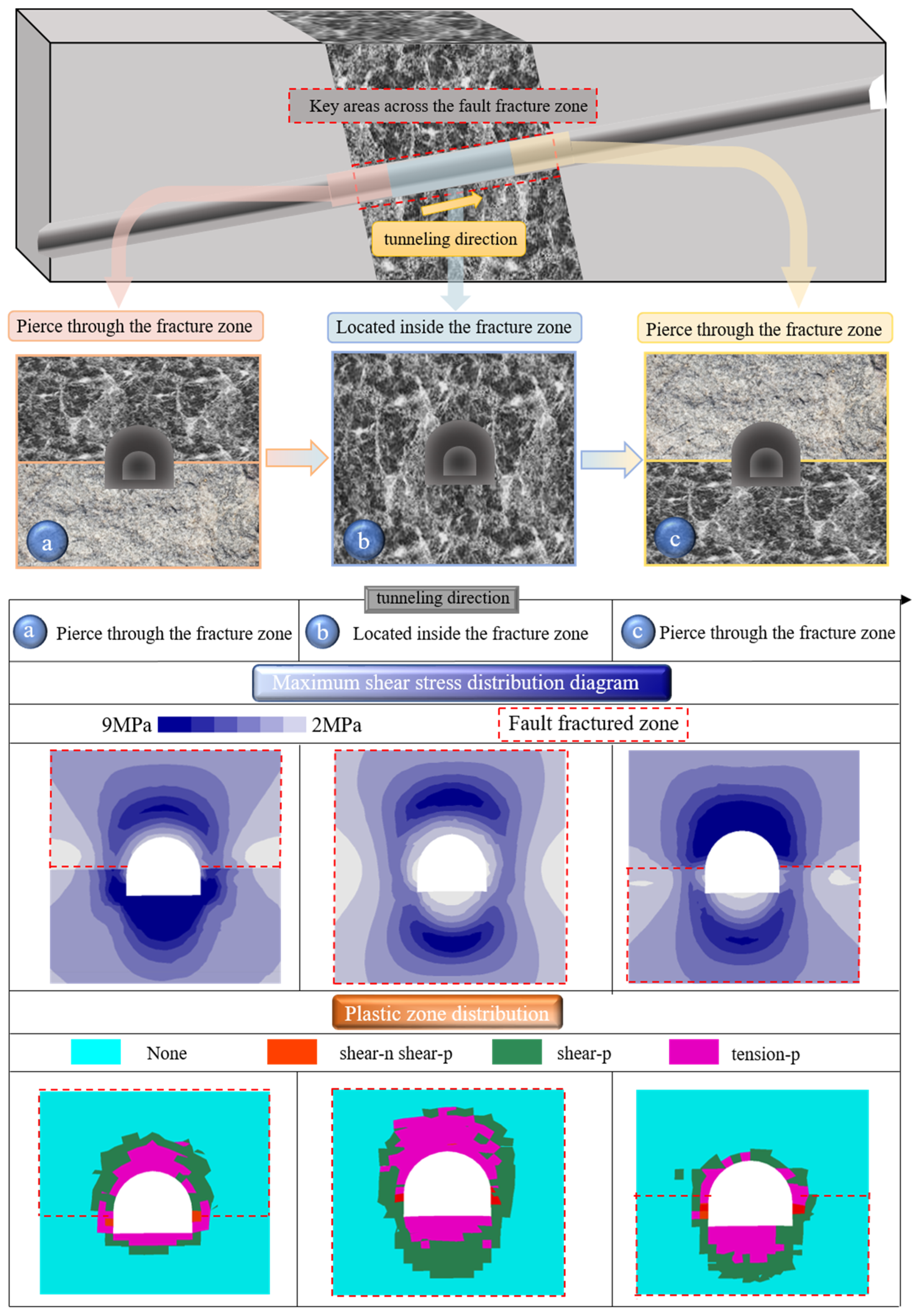
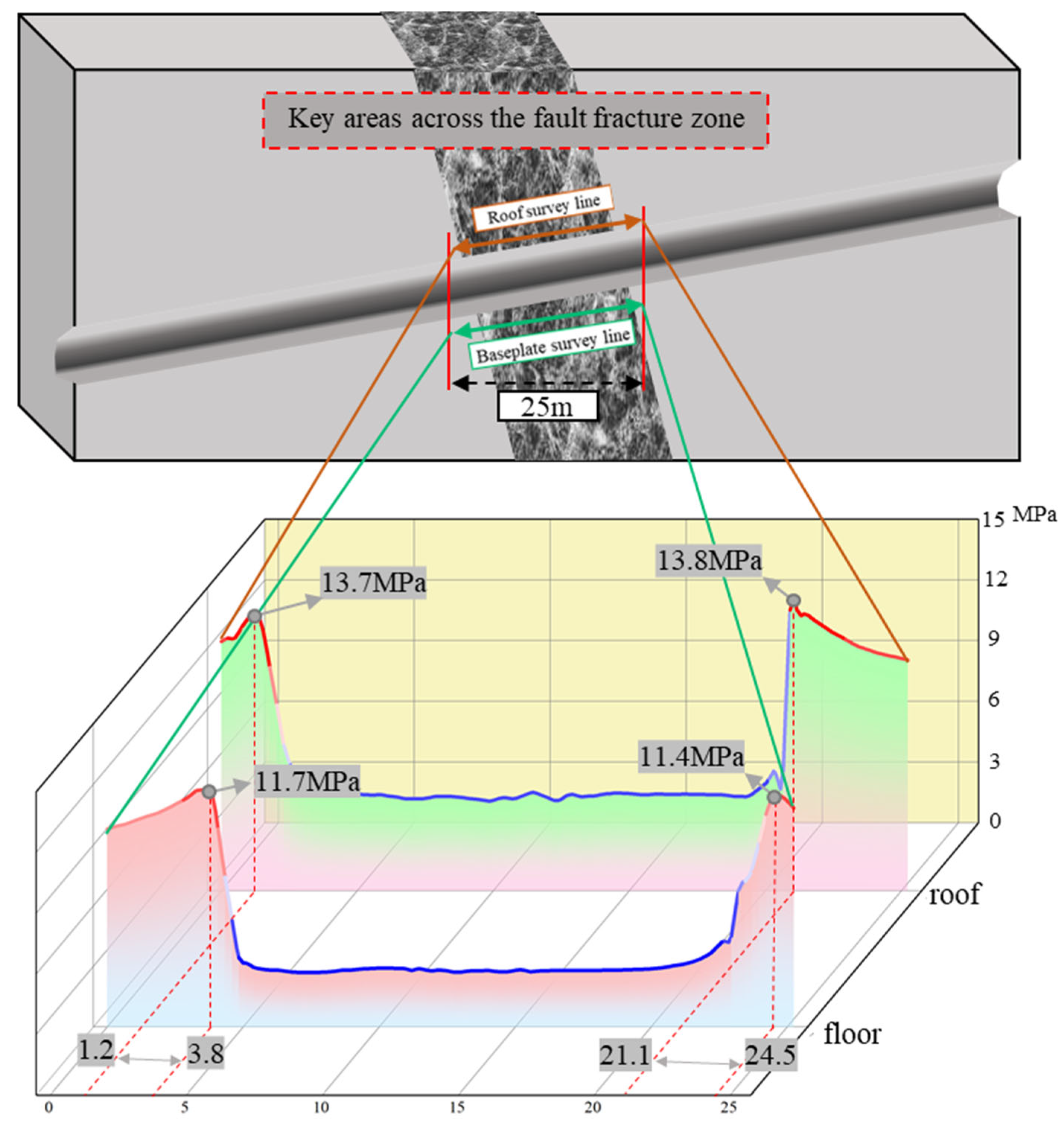
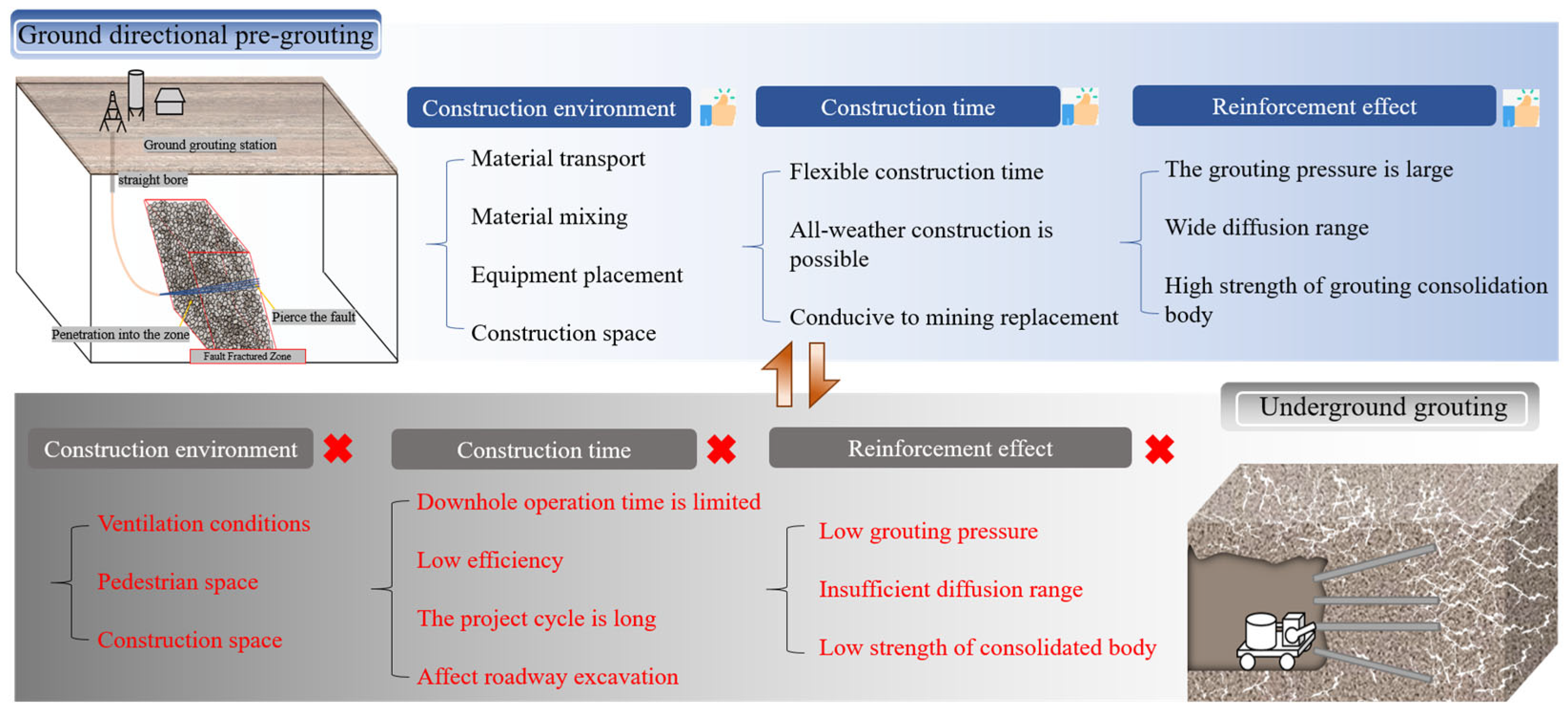

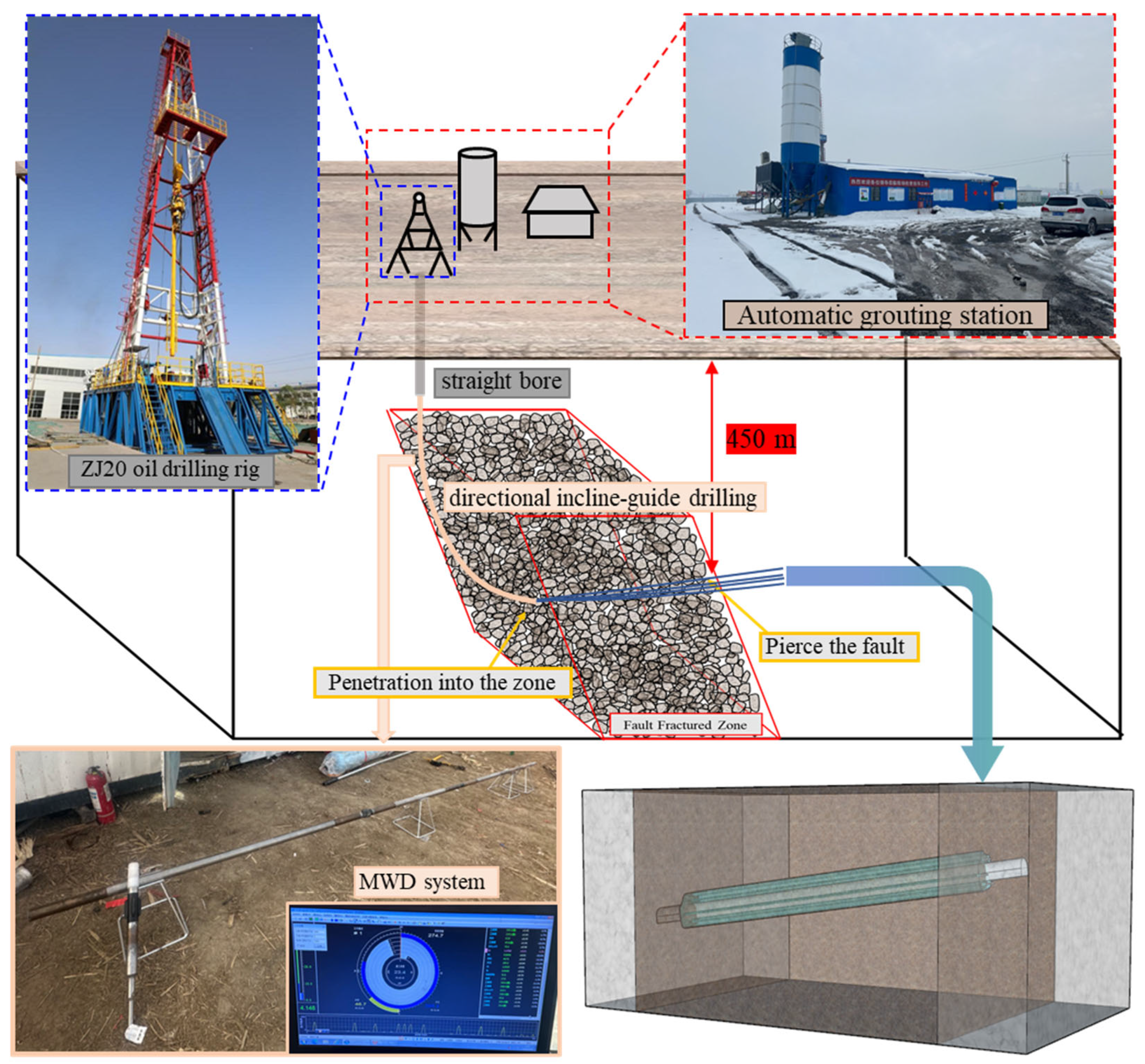
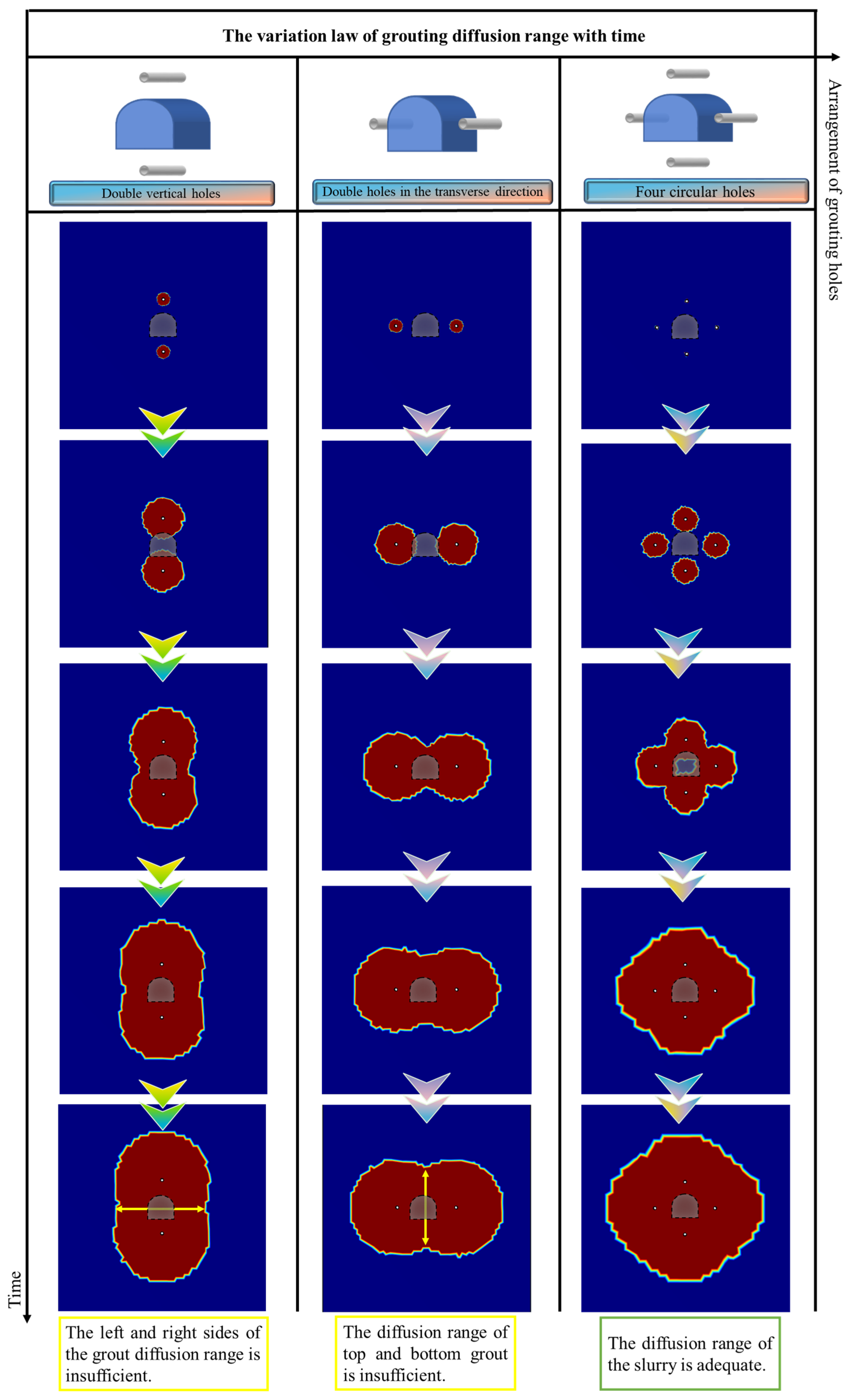
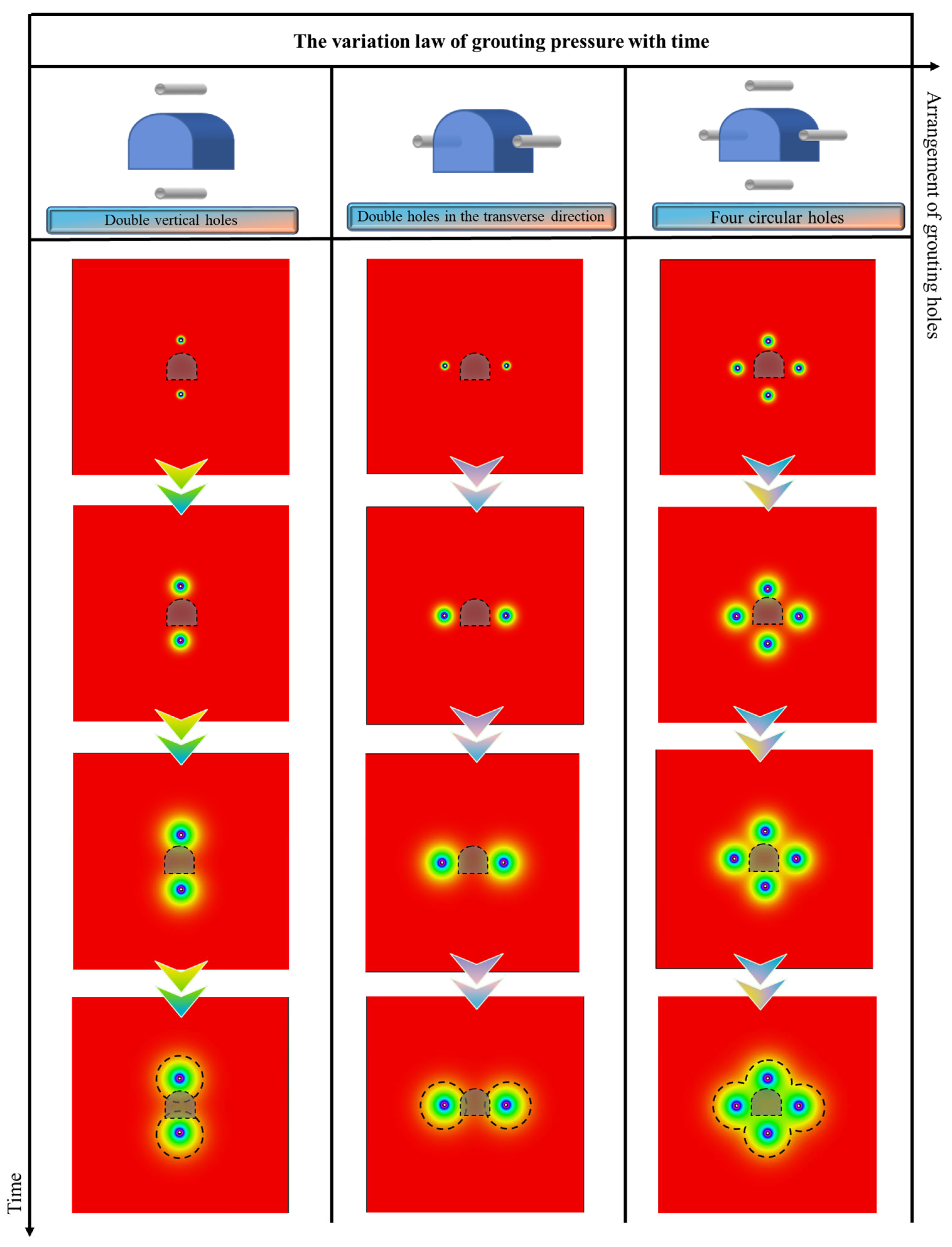
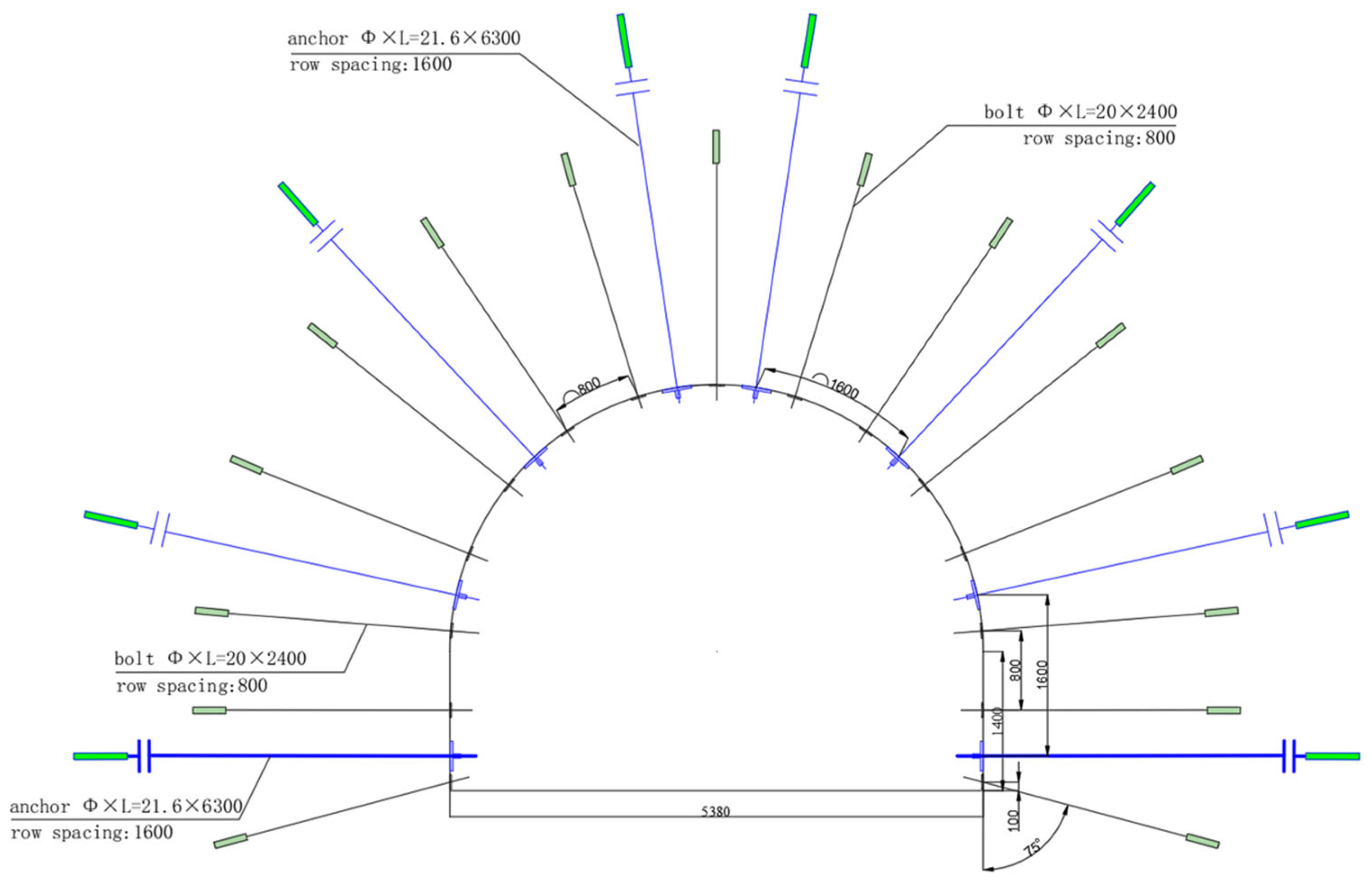

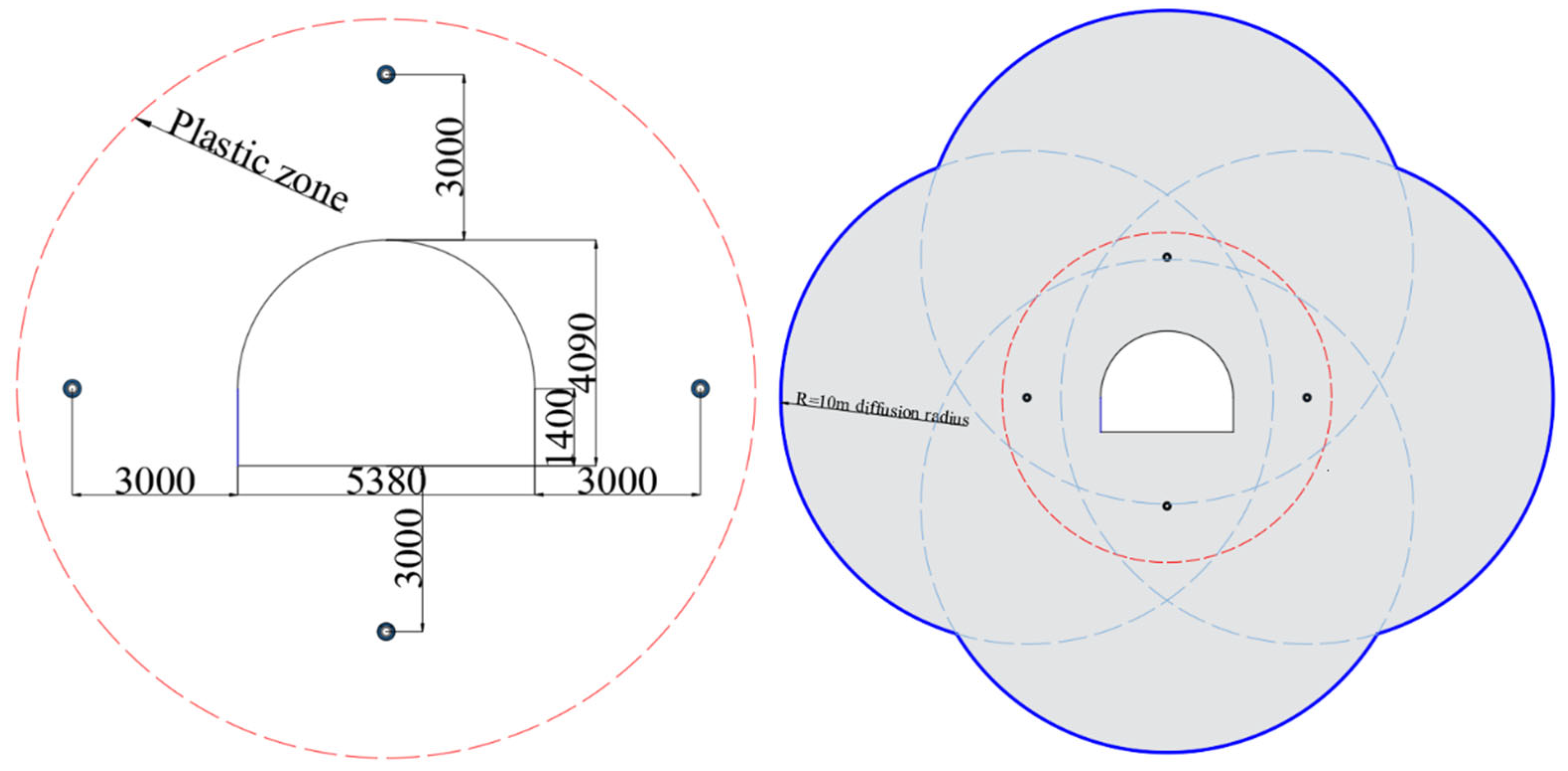
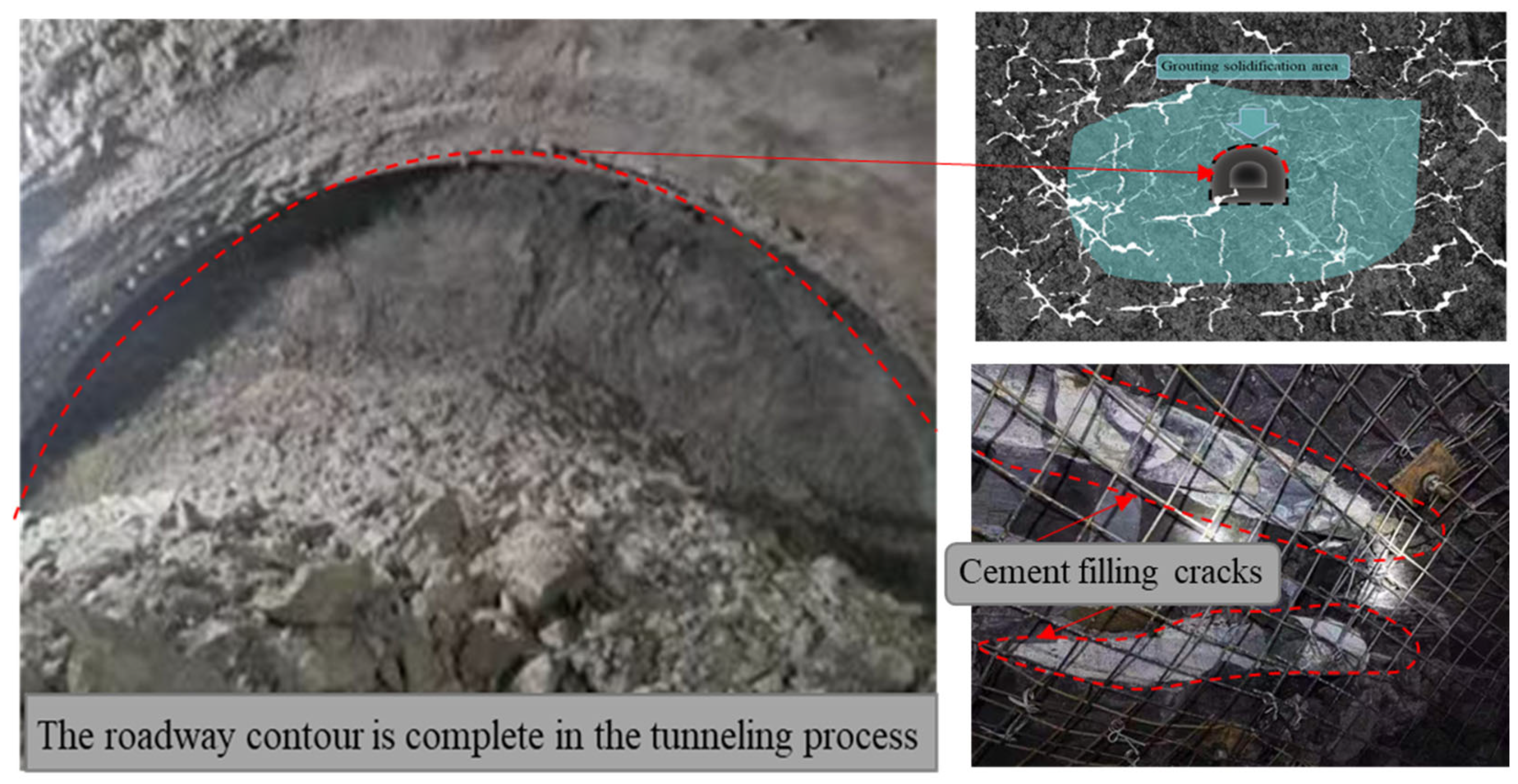
Disclaimer/Publisher’s Note: The statements, opinions and data contained in all publications are solely those of the individual author(s) and contributor(s) and not of MDPI and/or the editor(s). MDPI and/or the editor(s) disclaim responsibility for any injury to people or property resulting from any ideas, methods, instructions or products referred to in the content. |
© 2025 by the authors. Licensee MDPI, Basel, Switzerland. This article is an open access article distributed under the terms and conditions of the Creative Commons Attribution (CC BY) license (https://creativecommons.org/licenses/by/4.0/).
Share and Cite
Xie, F.; Zhang, Z.; He, W.; Chen, D. Research on Ground Directional Grouting Reinforcement Technology and Coupling Control of Fault Fracture Zone Through Rock Roadway. Appl. Sci. 2025, 15, 5647. https://doi.org/10.3390/app15105647
Xie F, Zhang Z, He W, Chen D. Research on Ground Directional Grouting Reinforcement Technology and Coupling Control of Fault Fracture Zone Through Rock Roadway. Applied Sciences. 2025; 15(10):5647. https://doi.org/10.3390/app15105647
Chicago/Turabian StyleXie, Fuxing, Zhixuan Zhang, Wen He, and Dongdong Chen. 2025. "Research on Ground Directional Grouting Reinforcement Technology and Coupling Control of Fault Fracture Zone Through Rock Roadway" Applied Sciences 15, no. 10: 5647. https://doi.org/10.3390/app15105647
APA StyleXie, F., Zhang, Z., He, W., & Chen, D. (2025). Research on Ground Directional Grouting Reinforcement Technology and Coupling Control of Fault Fracture Zone Through Rock Roadway. Applied Sciences, 15(10), 5647. https://doi.org/10.3390/app15105647




